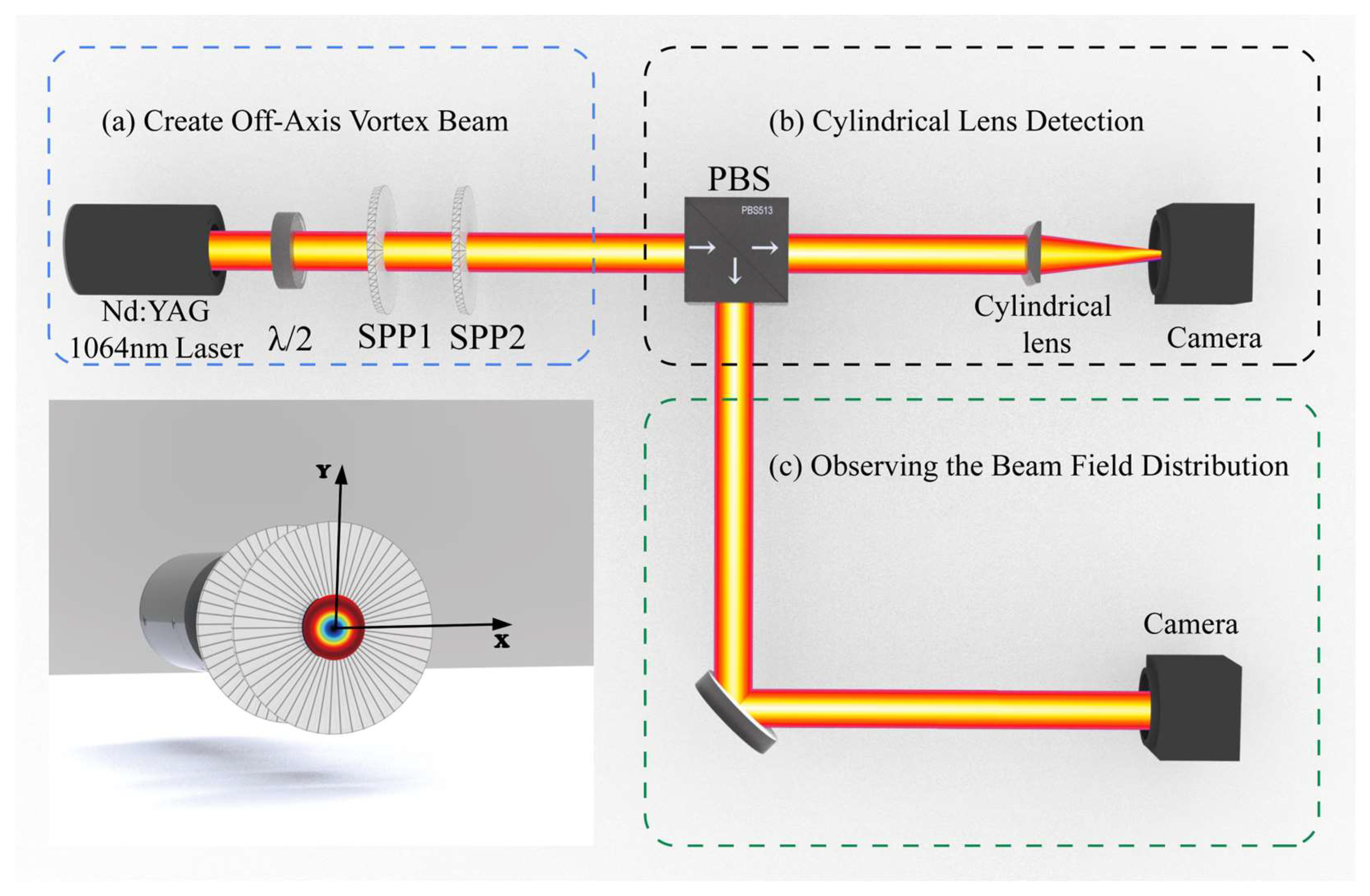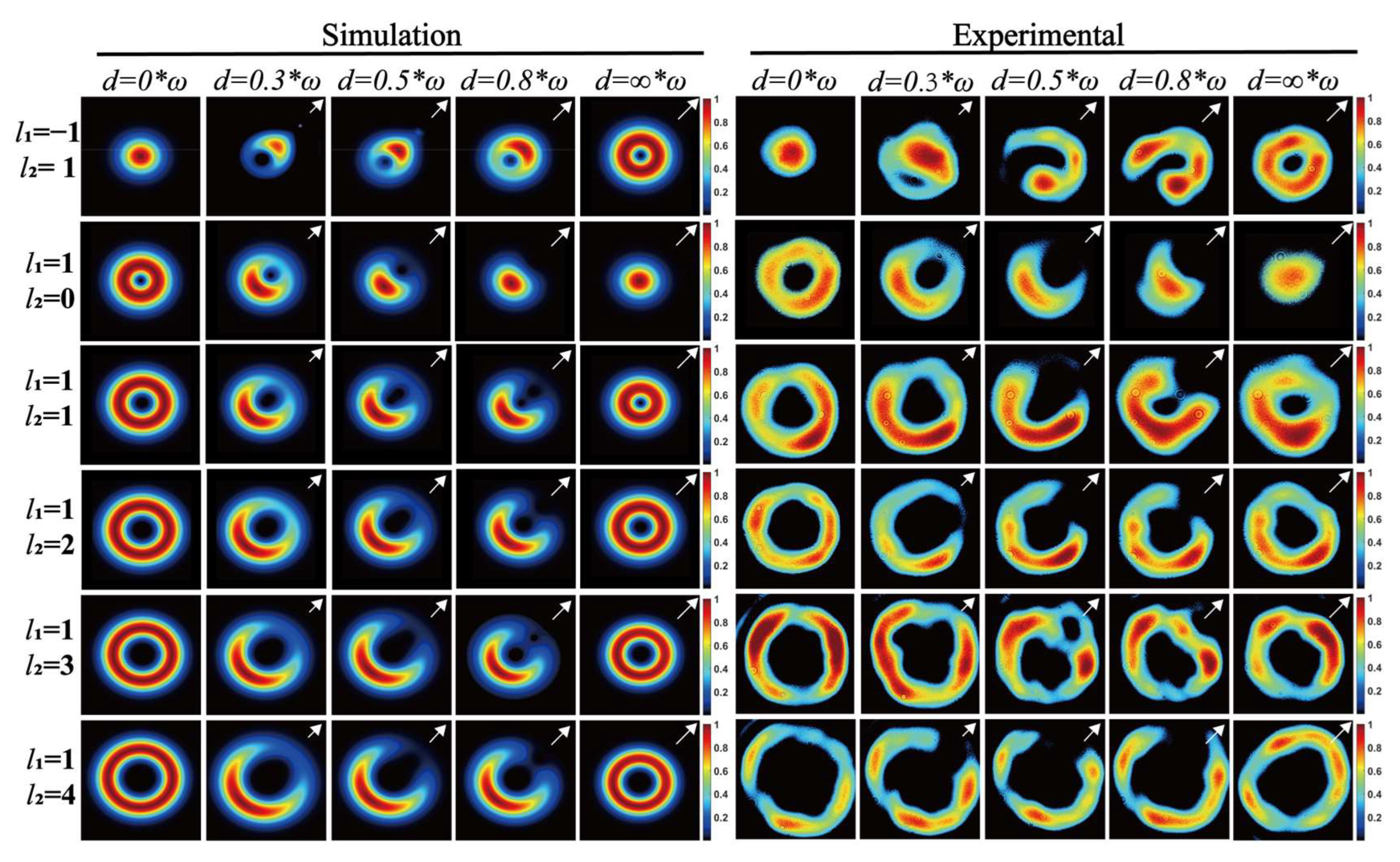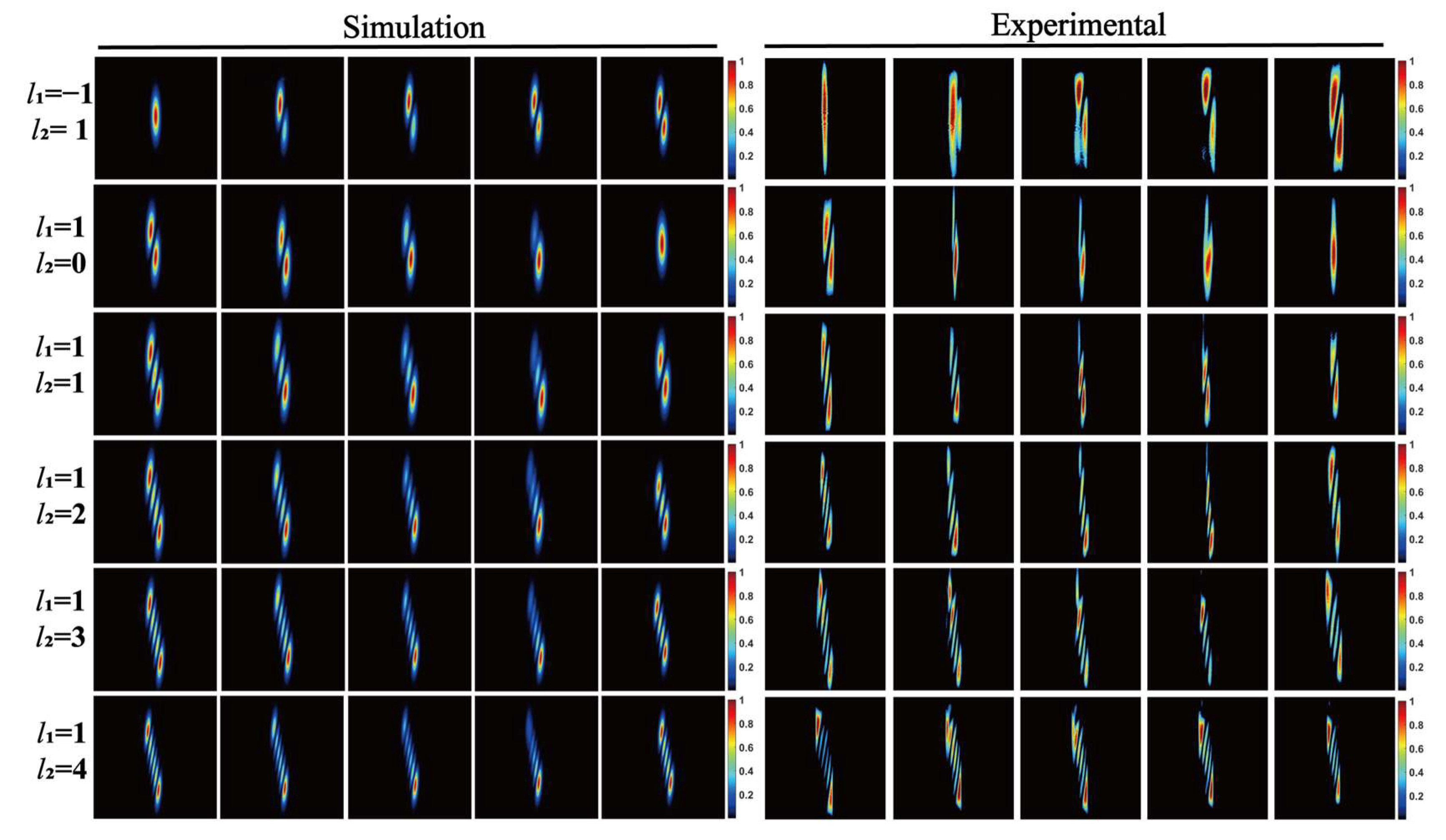Numerical Analysis and Verification of Off-Axis Double Vortex Beams
Abstract
1. Introduction
2. Theoretical Derivation of Off-Axis Double Vortex Beams
3. Experimental Results
3.1. Spatial Profile of Off-Axis Double Vortex Beams
3.2. Cylindrical Lens Focusing Patterns of Off-Axis Double Vortex Beams
4. Conclusions
Author Contributions
Funding
Institutional Review Board Statement
Informed Consent Statement
Data Availability Statement
Conflicts of Interest
References
- Allen, L.; Beijersbergen, M.W.; Spreeuw, R.J.C.; Woerdman, J.P. Orbital Angular Momentum of Light and the Transformation of Laguerre-Gaussian Laser Modes. Phys. Rev. A 1992, 45, 8185–8189. [Google Scholar] [CrossRef]
- Ruffato, G.; Massari, M.; Romanato, F. Generation of High-Order Laguerre–Gaussian Modes by Means of Spiral Phase Plates. Opt. Lett. 2014, 39, 5094–5097. [Google Scholar] [CrossRef] [PubMed]
- JJ Nivas, J.; He, S.; Rubano, A.; Vecchione, A.; Paparo, D.; Marrucci, L.; Bruzzese, R.; Amoruso, S. Direct Femtosecond Laser Surface Structuring with Optical Vortex Beams Generated by a Q-Plate. Sci. Rep. 2015, 5, 17929. [Google Scholar] [CrossRef]
- Wu, Y.; Wen, J.; Zhang, M.; Wen, J.; Chen, W.; Zhang, X.; Pang, F.; Tang, F.; West, G.; Wang, T. Over 100 Nm Bandwidth Orbital Angular Momentum Modes Amplification for MDM and WDM Transmission with a Ring-Core Bi/Er Co-Doped Fiber. J. Light. Technol. 2022, 40, 7922–7929. [Google Scholar] [CrossRef]
- Wu, Y.; Wen, J.; Tang, F.; Pang, F.; Guo, H.; Huang, S.; Wang, T. Orbital-Angular-Momentum Fluorescence Emission Based on Photon–Electron Interaction in a Vortex Field of an Active Optical Fiber. Nanophotonics 2023, 12, 43–53. [Google Scholar] [CrossRef]
- Wu, Y.; Wen, J.; Zhang, M.; Cao, Y.; Chen, W.; Zhang, X.; Yusufu, T.; Pang, F.; Wang, T. Low-Loss and Helical-Phase-Dependent Selective Excitation of High-Order Orbital Angular Momentum Modes in a Twisted Ring-Core Fiber. Opt. Lett. 2022, 47, 4016–4019. [Google Scholar] [CrossRef]
- Clark, T.W.; Offer, R.F.; Franke-Arnold, S.; Arnold, A.S.; Radwell, N. Comparison of Beam Generation Techniques Using a Phase Only Spatial Light Modulator. Opt. Express 2016, 24, 6249–6264. [Google Scholar] [CrossRef]
- Goorden, S.A.; Bertolotti, J.; Mosk, A.P. Superpixel-Based Spatial Amplitude and Phase Modulation Using a Digital Micromirror Device. Opt. Express 2014, 22, 17999–18009. [Google Scholar] [CrossRef]
- Marrucci, L.; Manzo, C.; Paparo, D. Optical Spin-to-Orbital Angular Momentum Conversion in Inhomogeneous Anisotropic Media. Phys. Rev. Lett. 2006, 96, 163905. [Google Scholar] [CrossRef]
- Khonina, S.N.; Kotlyar, V.V.; Skidanov, R.V.; Soifer, V.A.; Laakkonen, P.; Turunen, J. Gauss–Laguerre Modes with Different Indices in Prescribed Diffraction Orders of a Diffractive Phase Element. Opt. Commun. 2000, 175, 301–308. [Google Scholar] [CrossRef]
- Zhang, H.; Zeng, J.; Lu, X.; Wang, Z.; Zhao, C.; Cai, Y. Review on Fractional Vortex Beam. Nanophotonics 2022, 11, 241–273. [Google Scholar] [CrossRef]
- Berry, M.V. Optical Vortices Evolving from Helicoidal Integer and Fractional Phase Steps. J. Opt. A Pure Appl. Opt. 2004, 6, 259. [Google Scholar] [CrossRef]
- Hebri, D.; Rasouli, S.; Dezfouli, A.M. Theory of Diffraction of Vortex Beams from Structured Apertures and Generation of Elegant Elliptical Vortex Hermite–Gaussian Beams. J. Opt. Soc. Am. A 2019, 36, 839–852. [Google Scholar] [CrossRef] [PubMed]
- Chen, Y.F.; Lai, Y.H.; Hsieh, M.X.; Hsieh, Y.H.; Tu, C.W.; Liang, H.C.; Huang, K.F. Wave Representation for Asymmetric Elliptic Vortex Beams Generated from the Astigmatic Mode Converter. Opt. Lett. 2019, 44, 2028–2031. [Google Scholar] [CrossRef] [PubMed]
- Tkachenko, G.; Chen, M.; Dholakia, K.; Mazilu, M. Is It Possible to Create a Perfect Fractional Vortex Beam? Optica 2017, 4, 330–333. [Google Scholar] [CrossRef]
- Zhou, Q.; Liu, M.; Zhu, W.; Chen, L.; Ren, Y.; Lezec, H.J.; Lu, Y.; Agrawal, A.; Xu, T. Generation of Perfect Vortex Beams by Dielectric Geometric Metasurface for Visible Light. Laser Photonics Rev. 2021, 15, 2100390. [Google Scholar] [CrossRef]
- Yusufu, T.; Tokizane, Y.; Yamada, M.; Miyamoto, K.; Omatsu, T. Tunable 2-μm Optical Vortex Parametric Oscillator. Opt. Express 2012, 20, 23666–23675. [Google Scholar] [CrossRef]
- Aadhi, A.; Samanta, G.K.; Kumar, S.C.; Ebrahim-Zadeh, M. Controlled Switching of Orbital Angular Momentum in an Optical Parametric Oscillator. Optica 2017, 4, 349–355. [Google Scholar] [CrossRef]
- Omatsu, T.; Miyamoto, K.; Lee, A.J. Wavelength-Versatile Optical Vortex Lasers. J. Opt. 2017, 19, 123002. [Google Scholar] [CrossRef]
- Niu, S.; Wang, S.; Ababaike, M.; Yusufu, T.; Miyamoto, K.; Omatsu, T. Tunable Near- and Mid-Infrared (1.36–1.63 μm and 3.07–4.81 μm) Optical Vortex Laser Source. Laser Phys. Lett. 2020, 17, 045402. [Google Scholar] [CrossRef]
- Ababaike, M.; Wang, S.; Aierken, P.; Omatsu, T.; Yusufu, T. Near and Mid-Infrared Optical Vortex Parametric Oscillator Based on KTA. Sci. Rep. 2021, 11, 8013. [Google Scholar] [CrossRef] [PubMed]
- Zhou, Y.; Yusufu, T.; Ma, Y.; Omatsu, T. Generation of Tunable, Non-Integer OAM States from an Optical Parametric Oscillator. Appl. Phys. Lett. 2023, 122, 121106. [Google Scholar] [CrossRef]
- Yusufu, T.; Niu, S.; Tuersun, P.; Tulake, Y.; Miyamoto, K.; Omatsu, T. Tunable 3 μm Optical Vortex Parametric Oscillator. Jpn. J. Appl. Phys. 2018, 57, 122701. [Google Scholar] [CrossRef]
- Abulikemu, A.; Yakufu, S.; Zhou, Y.X.; Yusufu, T. Mid-Infrared Idler-Resonant Optical Vortex Parametric Oscillator Based on MgO:PPLN. Opt. Laser Technol. 2024, 171, 110341. [Google Scholar] [CrossRef]
- Zhu, L.; Tang, M.; Li, H.; Tai, Y.; Li, X. Optical Vortex Lattice: An Exploitation of Orbital Angular Momentum. Nanophotonics 2021, 10, 2487–2496. [Google Scholar] [CrossRef]
- Qiao, Z.; Wan, Z.; Xie, G.; Wang, J.; Qian, L.; Fan, D. Multi-Vortex Laser Enabling Spatial and Temporal Encoding. PhotoniX 2020, 1, 13. [Google Scholar] [CrossRef]
- Shao, W.; Huang, S.; Liu, X.; Chen, M. Free-Space Optical Communication with Perfect Optical Vortex Beams Multiplexing. Opt. Commun. 2018, 427, 545–550. [Google Scholar] [CrossRef]
- Ding, D.-S.; Zhang, W.; Zhou, Z.-Y.; Shi, S.; Xiang, G.-Y.; Wang, X.-S.; Jiang, Y.-K.; Shi, B.-S.; Guo, G.-C. Quantum Storage of Orbital Angular Momentum Entanglement in an Atomic Ensemble. Phys. Rev. Lett. 2015, 114, 050502. [Google Scholar] [CrossRef]
- Ndagano, B.; Nape, I.; Cox, M.A.; Rosales-Guzman, C.; Forbes, A. Creation and Detection of Vector Vortex Modes for Classical and Quantum Communication. J. Light. Technol. 2018, 36, 292–301. [Google Scholar] [CrossRef]
- Tan, P.S.; Yuan, X.-C.; Yuan, G.H.; Wang, Q. High-Resolution Wide-Field Standing-Wave Surface Plasmon Resonance Fluorescence Microscopy with Optical Vortices. Appl. Phys. Lett. 2010, 97, 241109. [Google Scholar] [CrossRef]
- Popiołek-Masajada, A.; Masajada, J.; Szatkowski, M. Internal Scanning Method as Unique Imaging Method of Optical Vortex Scanning Microscope. Opt. Lasers Eng. 2018, 105, 201–208. [Google Scholar] [CrossRef]
- Zheng, C.; Li, H.; Zang, H.; Yao, J. Terahertz Polarization Detection Based on the Mode Analysis of Longitudinally Polarized Vortices. Opt. Laser Technol. 2024, 170, 110210. [Google Scholar] [CrossRef]
- Zheng, C.; Liu, J.; Li, H.; Wang, M.; Zang, H.; Zhang, Y.; Yao, J. Terahertz Metasurface Polarization Detection Employing Vortex Pattern Recognition. Photon. Res. 2023, 11, 2256–2263. [Google Scholar] [CrossRef]
- Toyoda, K.; Miyamoto, K.; Aoki, N.; Morita, R.; Omatsu, T. Using Optical Vortex to Control the Chirality of Twisted Metal Nanostructures. Nano Lett. 2012, 12, 3645–3649. [Google Scholar] [CrossRef] [PubMed]
- Hnatovsky, C.; Shvedov, V.G.; Krolikowski, W.; Rode, A.V. Materials Processing with a Tightly Focused Femtosecond Laser Vortex Pulse. Opt. Lett. 2010, 35, 3417–3419. [Google Scholar] [CrossRef] [PubMed]
- Zhou, Z.-Y.; Li, Y.; Ding, D.-S.; Zhang, W.; Shi, S.; Shi, B.-S. Optical Vortex Beam Based Optical Fan for High-Precision Optical Measurements and Optical Switching. Opt. Lett. 2014, 39, 5098–5101. [Google Scholar] [CrossRef] [PubMed]
- Leach, J.; Yao, E.; Padgett, M.J. Observation of the Vortex Structure of a Non-Integer Vortex Beam. New J. Phys. 2004, 6, 71. [Google Scholar] [CrossRef]
- Fang, Y.; Lu, Q.; Wang, X.; Zhang, W.; Chen, L. Fractional-Topological-Charge-Induced Vortex Birth and Splitting of Light Fields on the Submicron Scale. Phys. Rev. A 2017, 95, 023821. [Google Scholar] [CrossRef]
- Maji, S.; Jacob, P.; Brundavanam, M.M. Geometric Phase and Intensity-Controlled Extrinsic Orbital Angular Momentum of Off-Axis Vortex Beams. Phys. Rev. Appl. 2019, 12, 054053. [Google Scholar] [CrossRef]
- Gao, B.; Wen, J.; Zhu, G.; Ye, L.; Wang, L.-G. Precise Measurement of Trapping and Manipulation Properties of Focused Fractional Vortex Beams. Nanoscale 2022, 14, 3123–3130. [Google Scholar] [CrossRef]
- Huang, K.; Liu, H.; Restuccia, S.; Mehmood, M.Q.; Mei, S.-T.; Giovannini, D.; Danner, A.; Padgett, M.J.; Teng, J.-H.; Qiu, C.-W. Spiniform Phase-Encoded Metagratings Entangling Arbitrary Rational-Order Orbital Angular Momentum. Light Sci. Appl. 2018, 7, 17156. [Google Scholar] [CrossRef]
- Götte, J.B.; O’Holleran, K.; Preece, D.; Flossmann, F.; Franke-Arnold, S.; Barnett, S.M.; Padgett, M.J. Light Beams with Fractional Orbital Angular Momentum and Their Vortex Structure. Opt. Express 2008, 16, 993–1006. [Google Scholar] [CrossRef] [PubMed]
- Kotlyar, V.V.; Kovalev, A.A.; Porfirev, A.P. Asymmetric Gaussian Optical Vortex. Opt. Lett. 2017, 42, 139–142. [Google Scholar] [CrossRef] [PubMed]
- Anzolin, G.; Tamburini, F.; Bianchini, A.; Barbieri, C. Method to Measure Off-Axis Displacements Based on the Analysis of the Intensity Distribution of a Vortex Beam. Phys. Rev. A 2009, 79, 033845. [Google Scholar] [CrossRef]
- Guo, M.; Le, W.; Wang, C.; Rui, G.; Zhu, Z.; He, J.; Gu, B. Generation, Topological Charge, and Orbital Angular Momentum of Off-Axis Double Vortex Beams. Photonics 2023, 10, 368. [Google Scholar] [CrossRef]
- Mitri, F.G. Vector Spherical Quasi-Gaussian Vortex Beams. Phys. Rev. E 2014, 89, 023205. [Google Scholar] [CrossRef] [PubMed]
- Mitri, F.G. Partial-Wave Series Expansions in Spherical Coordinates for the Acoustic Field of Vortex Beams Generated from a Finite Circular Aperture. IEEE Trans. Ultrason. Ferroelectr. Freq. Control 2014, 61, 2089–2097. [Google Scholar] [CrossRef] [PubMed]
- Indebetouw, G. Optical Vortices and Their Propagation. J. Mod. Opt. 1993, 40, 73–87. [Google Scholar] [CrossRef]
- Weng, X.; Miao, Y.; Wang, G.; Zhan, Q.; Dong, X.; Qu, J.; Gao, X.; Zhuang, S. Propagable Optical Vortices with Natural Noninteger Orbital Angular Momentum in Free Space. Adv. Photonics Res. 2023, 4, 2200094. [Google Scholar] [CrossRef]
- Zeng, J.; Liu, X.; Wang, F.; Zhao, C.; Cai, Y. Partially Coherent Fractional Vortex Beam. Opt. Express 2018, 26, 26830–26844. [Google Scholar] [CrossRef]
- Peng, Y.; Gan, X.-T.; Ju, P.; Wang, Y.-D.; Zhao, J.-L. Measuring Topological Charges of Optical Vortices with Multi-Singularity Using a Cylindrical Lens. Chin. Phys. Lett. 2015, 32, 024201. [Google Scholar] [CrossRef]



Disclaimer/Publisher’s Note: The statements, opinions and data contained in all publications are solely those of the individual author(s) and contributor(s) and not of MDPI and/or the editor(s). MDPI and/or the editor(s) disclaim responsibility for any injury to people or property resulting from any ideas, methods, instructions or products referred to in the content. |
© 2024 by the authors. Licensee MDPI, Basel, Switzerland. This article is an open access article distributed under the terms and conditions of the Creative Commons Attribution (CC BY) license (https://creativecommons.org/licenses/by/4.0/).
Share and Cite
Ye, J.; Zhou, Y.; Aierken, P.; Yang, X.; Li, Z.; Yusufu, T. Numerical Analysis and Verification of Off-Axis Double Vortex Beams. Photonics 2024, 11, 123. https://doi.org/10.3390/photonics11020123
Ye J, Zhou Y, Aierken P, Yang X, Li Z, Yusufu T. Numerical Analysis and Verification of Off-Axis Double Vortex Beams. Photonics. 2024; 11(2):123. https://doi.org/10.3390/photonics11020123
Chicago/Turabian StyleYe, Jianqiang, Yuxia Zhou, Palidan Aierken, Xining Yang, Zhaoxue Li, and Taximaiti Yusufu. 2024. "Numerical Analysis and Verification of Off-Axis Double Vortex Beams" Photonics 11, no. 2: 123. https://doi.org/10.3390/photonics11020123
APA StyleYe, J., Zhou, Y., Aierken, P., Yang, X., Li, Z., & Yusufu, T. (2024). Numerical Analysis and Verification of Off-Axis Double Vortex Beams. Photonics, 11(2), 123. https://doi.org/10.3390/photonics11020123




